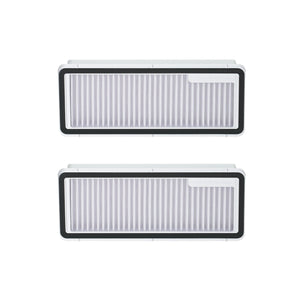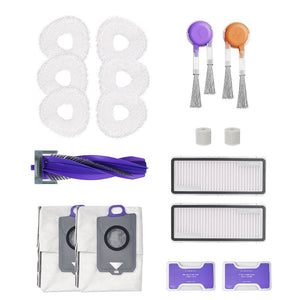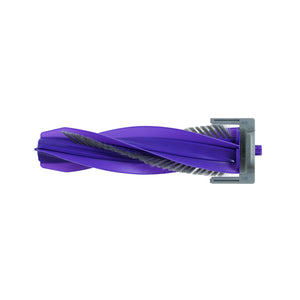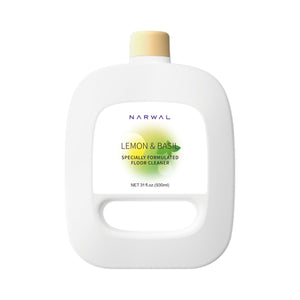Robot vacuums and robot mops are both smart machines that help clean your home. But they are made for different jobs. Some clean up dry messes like dust. Others clean wet messes like spills.
This guide will show you the difference between the two. It will also help you pick the one that works best for your home and your floors.
What is a Robot Vacuum?
A robot vacuum is a smart machine that picks up dust, dirt, and pet hair from your floors. It moves on its own and uses suction to pull dry messes into a small bin. Robot vacuums can clean many floor types, like carpet, wood, and tile. They are great for daily cleaning, especially in homes with pets or lots of foot traffic.
What is a Robot Mop?
A robot mop is a smart cleaner made for wet messes. It uses water and a soft mop pad to clean your floors. As it moves, it wipes away things like spills, sticky spots, and stains. Most robot mops are made for hard floors, such as tile, wood, or laminate. They are a good choice for kitchens or homes without carpets.
Robot Vacuum vs Robot Mop – Key Differences by Product Type
Want to know which robot fits your home best? Here's a quick side-by-side look at what each type does well—and where they may not be the best match.
|
Product Type |
Best For |
Not Good For |
Floor Types |
Care Needed |
|
Robot Vacuum |
Dry messes like dust, crumbs, and pet hair |
Wet messes like spills or sticky spots |
Carpet, hardwood, tile |
Empty dustbin, clean brushes |
|
Robot Mop |
Wet messes like stains and spills |
Carpet and rugs |
Hardwood, tile, laminate |
Refill water, clean mop pads |
Robot Vacuum or Robot Mop: How to Choose the Right One
Not sure which robot is right for your home? Start by thinking about what kind of messes you clean up most and what type of floors you have.
-
Choose a robot vacuum if you often have dry messes like dust, crumbs, or pet hair. It works well on carpets, rugs, and hard floors.
-
Choose a robot mop if your floors are mostly hard surfaces like wood or tile, and you need to clean up wet messes like spills or sticky spots.
A robot vacuum is great for daily use and general cleaning. A robot mop is better if you want to keep your hard floors shiny and clean from stains.
Real-Life Examples: Which Robot Fits Your Home?
Still not sure which robot to pick? Let’s look at some real-life home setups and which robot works best for each one.
-
You live in an apartment with pets and rugs. A robot vacuum is the better choice. It picks up hair and dirt from carpet and keeps things clean every day.
-
You have a big kitchen with tile floors and lots of spills. A robot mop will help most. It can clean up sticky spots and keep your floors looking nice.
-
Your home has all tile or wood floors and light foot traffic. Either a mop or a small vacuum can work. It depends on whether you want to clean dry dust or wet messes.
-
Your house has mostly carpeted rooms. A robot vacuum is best. Mops don’t work well on carpet.
Basic Functions: What Do These Machines Actually Do?
Let’s first explore the main functions of each robot cleaner before getting into the technical specifics.
-
Robot Vacuums are designed to pick up dry debris using powerful suction. They pick up dust, dirt, crumbs, pet fur, and tiny debris from your floors. These devices usually have rotating brushes or rollers to dislodge debris from carpets or hard floors and suck it into a dustbin.
-
Robot Mops, on the other hand, are focused on cleaning your floors with water, detergents, or other cleaning solutions. Their primary function is to tackle wet messes like spills, stains, or sticky substances that robot vacuums can't handle. These devices typically have a mop pad that dispenses water or cleaning solution as they move across the floor, leaving it spotless and gleaming.
Cleaning Mechanism: How Do They Work?
The way these two types of robots clean your home is very different, and understanding these mechanisms will help you choose the right one.
-
Robot Vacuums use suction power combined with rotating brushes or rollers to collect dirt and debris. They are capable of cleaning different types of flooring, such as carpets, wood, and tiles. The vacuum works by creating airflow that pulls dirt into the dustbin, where it stays until you empty it. Some advanced models even offer automatic emptying features, which make the process easier.
-
Robot Mops use a combination of mop pads and water (or cleaning solutions) to scrub the floor. As they move, the mop pads are moistened, and they wipe away dirt, sticky residues, and stains. The water tank in a robot mop supplies the moisture for cleaning, and in some models, there’s an automatic detergent dispenser that mixes the cleaning solution with water. Unlike robot vacuums, mops are usually intended only for hard floors like wood, tiles, or vinyl.
Surface Compatibility: Which Floors Do They Clean Best?
One of the key differences between robot vacuums and mops lies in the types of surfaces they are optimized for.
-
Robot vacuums offer great flexibility. They are capable of cleaning various types of floors, such as carpets, hardwood, tile, and rugs. Some models can adjust their suction power based on the surface they’re cleaning, providing optimal results whether they are on carpet or smooth floors.
-
Robot Mops, on the other hand, are best suited for hard surfaces such as hardwood, laminate, or tile floors. They cannot clean carpets effectively, and some models may struggle with thick rugs. Since mopping involves wet cleaning, it’s more ideal for surfaces where water and cleaning solutions won’t cause damage.
Design Features: What Makes Each One Unique?
Both robot vacuums and robot mops come with features designed to enhance their performance, but these features vary depending on the task at hand.
-
Robot Vacuums typically have a dustbin or collection chamber where dirt and debris are stored. Depending on the model, the dustbin can be emptied manually or automatically when the vacuum returns to its charging station. The vacuum’s design often includes rotating brushes or rollers that agitate dirt, allowing the suction to pull it in. They also feature sensors that help them navigate the room and avoid obstacles.
-
Robot Mops come with a water tank and mop pads. The water tank stores water or cleaning liquids, which are released onto the mop pads. Some models have self-cleaning pads, while others require you to clean and replace them manually. Many robot mops are also equipped with sensors that allow them to adjust their water output based on the floor type or level of dirt.
Maintenance Requirements: How Much Effort Is Involved?
While both devices aim to make cleaning easier, they still require some level of maintenance to keep performing at their best.
-
Robot Vacuums need regular emptying of the dustbin, and some models also require filter cleaning or replacement every few months. Additionally, the brushes or rollers might get tangled with pet hair or debris, which means you’ll need to remove these regularly to keep the vacuum running smoothly. The frequency of maintenance varies, from once a week to once a month, based on cleaning needs.
-
Robot Mops require you to refill the water tank frequently, especially for larger cleaning sessions. Some models feature a self-cleaning mop pad, but others will need the mop pad to be washed and replaced regularly. You should clean the water tank now and then to avoid mold or bacteria growth. If you’re using a robot mop that dispenses detergent, the detergent compartment needs to be cleaned and refilled as well.
Performance Comparison: Which One Does the Job Better?
The cleaning efficiency of the two varies in several key areas.
-
Robot Vacuums excel at handling dry debris, such as dust, dirt, crumbs, and pet hair. Their suction power and rotating brushes make them very effective at picking up even the smallest particles. They are also quick and efficient, making them ideal for everyday cleaning tasks. However, they won’t do much for wet spills or sticky messes, which is where robot mops shine.
-
Robot Mops perform better with wet messes and stains. The mop pads scrub away sticky residue, liquids, and stubborn dirt that a vacuum cannot handle. However, they are not as effective as vacuums when it comes to dry debris. While a mop may leave your floor spotless in terms of moisture, it might not pick up crumbs or dust as efficiently as a vacuum would.
Pros and Cons of Each Device
Here’s a brief overview of the pros and cons of robot vacuums and robot mops.
Robot Vacuums:
-
Pros: Great for everyday maintenance, excellent at handling dry messes, works on various surfaces, and saves time and energy.
-
Cons: Not effective on wet messes, requires regular dustbin emptying, and maintenance is needed for the brushes and filters.
Robot Mops:
-
Pros: Exceptional at handling wet messes, great for deep cleaning hard floors, and perfect for removing sticky stains.
-
Cons: Limited to hard floors, less efficient at picking up dry debris, requires more frequent maintenance (water tank refills, mop pad cleaning).
Robot Vacuum-Mop Combos: A Convenient Solution
Robot vacuum-mop combos offer the convenience of cleaning your floors with just one device. These hybrids allow you to vacuum and mop simultaneously, saving time and effort, especially in homes with limited space.
For many, the idea of having one device to vacuum and mop at the same time is incredibly appealing. It means less hassle and more efficiency. However, while these combos are convenient, they may not perform as well as specialized models in certain areas. For example, a robot vacuum-mop combo may not have the same suction power as a dedicated vacuum or the same wet cleaning capability as a robot mop.
Narwal Freo Z Ultra: The Hybrid That Delivers
The Narwal Freo Z Ultra is a top choice among robot vacuum-mop hybrids. It doesn’t just combine vacuuming and mopping; it excels in both tasks. Here’s why:
[cta:narwal-freo-z-ultra-robot-vacuum-mop]
-
Powerful Suction: With 12,000 Pa suction, the Freo Z Ultra can effectively pick up dirt, dust, and debris from carpets and hard floors.
-
AI-Powered Navigation: Dual RGB cameras and onboard AI allow the robot to navigate your space intelligently, avoiding obstacles and mapping out the most efficient cleaning path.
-
Self-Cleaning and Low Maintenance: The Freo Z Ultra features a self-cleaning system for the mop, ensuring you don’t have to manually wash the mop pads after every use. It also has a self-emptying dustbin, which can hold up to 120 days of dirt, reducing the need for frequent maintenance.
-
Mop Mode: The robot’s dual spinning mops use a pressure system to clean hard floors efficiently, providing deep cleaning, especially for sticky or dried stains.
-
Quiet Operation: Despite its powerful performance, the Freo Z Ultra operates at a quiet 53 dB, which is ideal for office or home environments where noise is a concern.
The Narwal Freo Z Ultra raises the bar for robot vacuum-mop hybrids. With strong suction, automatic cleaning features, and smart navigation, it stands out as a leading option for simplifying your cleaning tasks. If you want a versatile, low-maintenance device that delivers in both vacuuming and mopping, the Freo Z Ultra is definitely worth considering.
Conclusion
In conclusion, whether you need a robot vacuum or a robot mop depends on your cleaning priorities. For thorough cleaning and flexibility, the Narwal Freo Z Ultra, a hybrid vacuum and mop, is an ideal choice. It combines powerful suction with efficient mopping, saving you time and effort. Choose wisely, and let technology make your cleaning routine easier!
Still not sure which type you need? Start by thinking about your floors: Are they mostly carpet or hardwood? Do you need dry cleaning or wet mopping? Once you know your daily cleaning needs, choosing the right robot becomes much easier.
FAQs
How Often Should I Maintain My Robot Vacuum or Mop?
Regular maintenance is essential. To maintain your device's performance, clean the brushes, empty the dustbin, and inspect for any obstructions every few weeks.
Can Robot Vacuums and Mops Effectively Clean Up Pet Hair?
Yes. Many robot vacuums and mops are built to tackle pet hair. However, regular upkeep might be needed to avoid hair wrapping around the brushes.
Do Robot Vacuums and Mops Work Well in Spacious Homes?
Yes, but for large homes, you'll need models with larger dustbins, longer battery life, and advanced mapping to cover multiple rooms effectively. For example, the Narwal Freo Z Ultra excels in larger spaces with its efficient navigation, powerful suction, and long battery life, making it an ideal choice for homes of any size.
Do Robot Mops Really Work?
Yes, robot mops can clean floors well, especially for small spills, sticky spots, or light dirt. They are not as strong as a full mop and bucket, but they’re great for keeping hard floors clean between deep cleanings.
Can a Robot Mop Replace Regular Mopping?
Not always. A robot mop is good for daily touch-ups and small messes. But if your floor has heavy dirt or dried-on stains, you may still need to mop by hand sometimes for a deeper clean.
Are Robot Vacuums Safe for Carpets?
Yes, most robot vacuums are made to clean carpets. They can pick up dust, crumbs, and pet hair. Some models can even move between carpets and hard floors without getting stuck.

























































